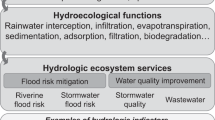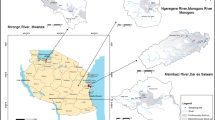Abstract
Transboundary water pollution has resulted in increasing conflicts between upstream and downstream administrative districts. Ecological compensation is an efficient means of restricting pollutant discharge and achieving sustainable utilization of water resources. The tri-provincial region of Taihu Basin is a typical river networks area. Pollutant flux across provincial boundaries in the Taihu Basin is hard to determine due to complex hydrologic and hydrodynamic conditions. In this study, ecological compensation estimation for the tri-provincial area based on a mathematical model is investigated for better environmental management. River discharge and water quality are predicted with the one-dimensional mathematical model and validated with field measurements. Different ecological compensation criteria are identified considering the notable regional discrepancy in sewage treatment costs. Finally, the total compensation payment is estimated. Our study indicates that Shanghai should be the receiver of payment from both Jiangsu and Zhenjiang in 2013, with 305 million and 300 million CNY, respectively. Zhejiang also contributes more pollutants to Jiangsu, and the compensation to Jiangsu is estimated as 9.3 million CNY. The proposed ecological compensation method provides an efficient way for solving the transboundary conflicts in a complex river networks area and is instructive for future policy-making.







Similar content being viewed by others
References
Chau KW, Jiang YW (2003) Simulation of transboundary pollutant transport action in the Pearl River delta. Chemosphere 52:1615–1621
Cuperus R, Bakermans MM, De Haes HA, Canters KJ (2001) Ecological compensation in Dutch highway planning. Environ Manag 27:75–89
Davies JM, Mazumder A (2003) Health and environmental policy issues in Canada: the role of watershed management in sustaining clean drinking water quality at surface sources. J Environ Manag 68:273–286
DHI (2009) MIKE 11: a modeling system for rivers and channels. Reference Manual. Danish Hydraulic Institute, Denmark
Doulgeris C, Georgiou P, Papadimos D, Papamichail D (2012) Ecosystem approach to water resources management using the MIKE 11 modeling system in the Strymonas River and Lake Kerkini. J Environ Manag 94:132–143
Environmental Protection Department of Jiangsu province (2008) Environmental resources compensation in pilot region of Taihu watershed in Jiangsu province, China. (in Chinese)
Han L (2008) Parameter estimation in channel network flow simulation. Water Science and Engineering 1(1):10–17
Hao C, Deng Y, Wang Y, Song X (2012) Study on the selection and error analysis of riverine pollutant flux estimation methods. Acta Sci Circumst 32:1670–1676
Havnø K, Madsen MN, Dørge J, Singh VP (1995) MIKE 11—a generalized river modelling package. Computer Models of Watershed Hydrology
Hu Z, Wang L, Tang H, Qi X (2017) Prediction of the future flood severity in plain river network region based on numerical model: a case study. J Hydrodyn 29:586–595
Jiang YZ, Jiang Y, Cheng X (2006) Problems and countermeasures of water resources protection in provincial boundary area of Taihu Basin. Water Resources Protection
Law of the People’s Republic of China on the Prevention and Control of Water Pollution since 2008 (Standing Committee of the National People's Congress) (2008)
Li Z, Liu M, Zhao Y, Liang T, Sha J, Wang Y (2014) Application of regional nutrient management model in Tunxi catchment: in support of the transboundary eco-compensation in Eastern China. CLEAN – Soil, Air, Water 42:1729–1739
Lin J, Li X (2016) Conflict resolution in the zoning of eco-protected areas in fast-growing regions based on game theory. J Environ Manag 170:177–185
Luo XJ, Fu-Tian QU, Feng SY, Shi XP, Jiang H (2011) Ecological compensation mechanism in Taihu Lake Basin: based on theory and experience of watershed ecological compensation in and out of China. J Nanjing Agricul Univ
Nikolaou AD, Meric S, Lekkas DF, Naddeo V, Belgiorno V, Groudev S, Tanik A (2008) Multi-parametric water quality monitoring approach according to the WFD application in Evros trans-boundary river basin: priority pollutant. Desalination 226:306–320
People’s Government of Jiangsu Province (2012) Jiangsu provincial “Twelve-Five” comprehensive program of energy conservation and emission reduction circulated by the Jiangsu Government
Perrotmaître D, Davis P (2004) Case studies of markets and innovative financial mechanisms for water services from forests. Am J Hum Biol 1:185–189
Qin BQ, Zhu GW, Gao GA, Zhang YL, Li W, Paerl HW, Carmichael WW, Margles SW, Peterson RB, Ervin J (2010) A drinking water crisis in Lake Taihu, China: linkage to climatic variability and lake management. Environ Manag 45:105–112
Shi GM, Wang JN, Zhang B, Zhang Z, Zhang YL (2016) Pollution control costs of a transboundary river basin: empirical tests of the fairness and stability of cost allocation mechanisms using game theory. J Environ Manag 177:145–152
Su F, Shang HY (2010) Relationship analysis between the response to participate in eco-compensation and livelihood assets: a Heihe River Basin example. Adv Mater Res 113-116:11–15
Wang QG, Gang G, Higano Y (2006) Toward integrated environmental management for challenges in water environmental protection of Lake Taihu Basin in China. Environ Manag 37:579–588
Wang H, Ji FQ, Xia K (2014) Water environment numerical simulation for a complicated river-lake system. Adv Mater Res 1010-1012:403–408
Wang X, Katopodes N, Shen CQ, Wang H, Pang Y (2016) Control of pollutant in the trans-boundary area of Taihu Basin, Yangtze Delta. Int J Environ Res Public Health 13(12):1312–1253
Wang P, Poe G, Wolf S (2017a) Payments for ecosystem services and wealth distribution. Ecol Econ 132:63–68
Wang X, Pang Y, Wang H, Shen C, Wang X (2017b) Emission control in river network system of Taihu Basin for water quality assurance in water environmentally sensitive areas. Sustainability 9(2):301
Xie R, Pang Y, Li Z, Zhang N, Hu F (2013) Eco-compensation in multi-district river networks in North Jiangsu, China. Environ Manag 51:874–881
Yin G, Liu L, Jiang X (2017) The sustainable arable land use pattern under the tradeoff of agricultural production, economic development, and ecological protection—an analysis of Dongting Lake basin, China. Environ Sci Pollut Res 24:25329–25345
Zhang H, Liu G, Wang J, Wan J (2007) Policy and practice progress of watershed eco-compensation in China. Chin Geogr Sci 17:179–185
Zhao L (2009) Model of collective cooperation and reallocation of benefits related to conflicts over water pollution across regional boundaries in a Chinese river basin. Environ Model Softw 24:603–610
Zhao L, Qian Y, Huang R, Li C, Xue J, Hu Y (2012) Model of transfer tax on transboundary water pollution in China’s river basin. Oper Res Lett 40:218–222
Zheng H, Zhang LB (2010) Chinese practices of ecological compensation and payments for ecological and environmental services and its policies in river basins. World Bank, Washington, DC
Zhong DS, Zhang HW (2005) Equal standard pollution load method for evaluating the effect of pollution source on aquatic environment. China Water & Wastewater 21:101–103
Zhuang W (2016) Eco-environmental impact of inter-basin water transfer project: a review. Environ Sci Pollut Res 23:12867–12879
Funding
This work was supported by the National Water Special Project of China (2012ZX07506-007).
Author information
Authors and Affiliations
Corresponding author
Additional information
Responsible editor: Marcus Schulz
Electronic supplementary material
ESM 1
(DOCX 2093 kb)
Rights and permissions
About this article
Cite this article
Wang, X., Shen, C., Wei, J. et al. Study of ecological compensation in complex river networks based on a mathematical model. Environ Sci Pollut Res 25, 22861–22871 (2018). https://doi.org/10.1007/s11356-018-2316-4
Received:
Accepted:
Published:
Issue Date:
DOI: https://doi.org/10.1007/s11356-018-2316-4




